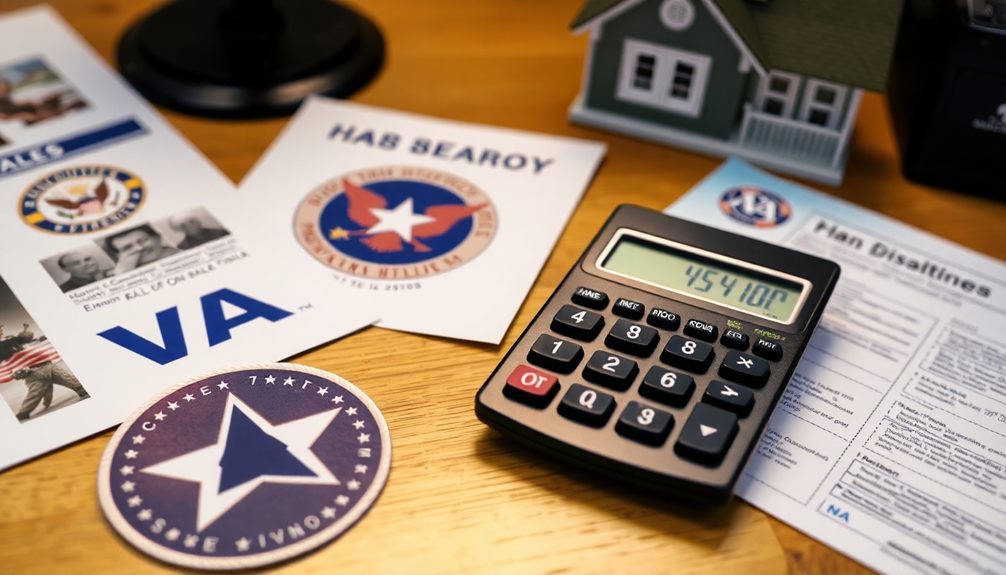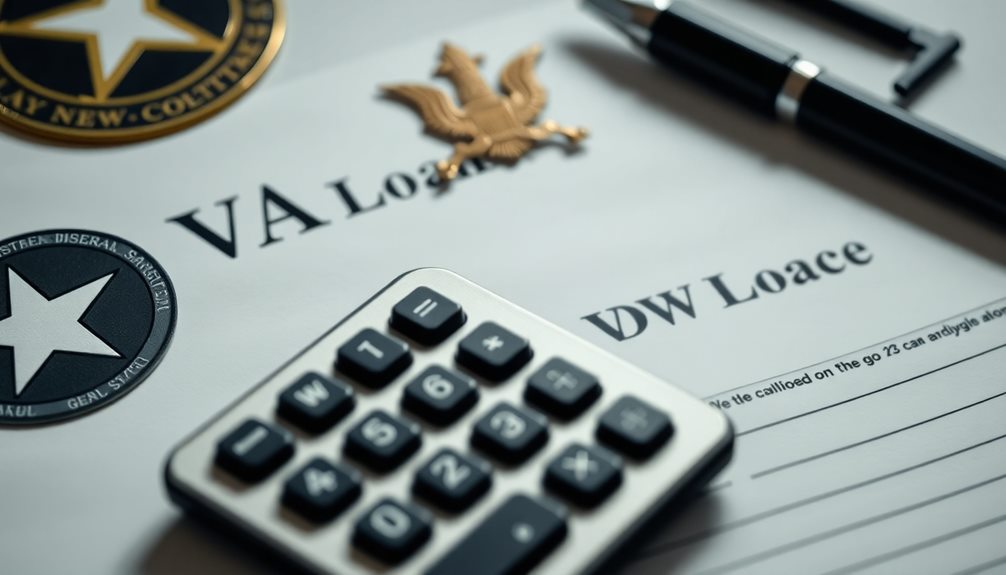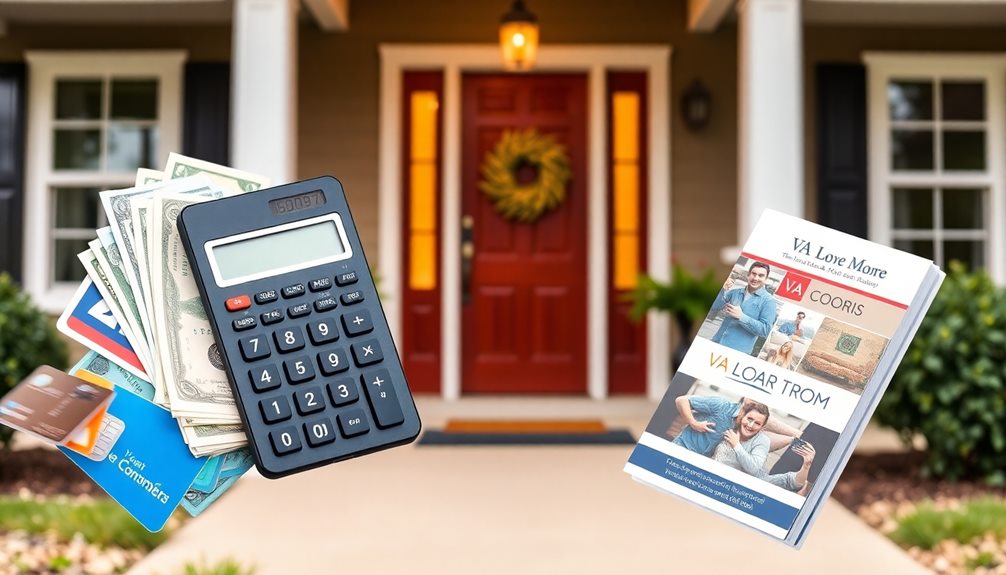The VA funding fee calculator is a key tool for estimating your loan costs. You can input your loan amount and military status to find out what percentage applies to you, ranging from 0% to 3.3%. First-time borrowers usually pay about 2.15%, while subsequent users without a down payment can face a higher fee. If you make a down payment of at least 5%, your fee may reduce to 1.5%. Additionally, many veterans can qualify for exemptions. With this calculator, you can better manage financial planning for your VA loan and discover potential savings.
Key Takeaways
- The VA funding fee calculator estimates costs based on loan amount, military status, and down payment options.
- Input your service-connected disability status to check for potential exemptions from the funding fee.
- The calculator adjusts estimates to show the impact of financing the funding fee into your mortgage.
- It provides real-time feedback on monthly payments to help with budgeting.
- Use the calculator alongside other resources to fully understand your VA loan costs and fees.
Understanding the VA Funding Fee

Understanding the VA funding fee is essential for anyone considering a VA loan. This one-time charge can range from 0% to 3.3% of your loan amount, depending on your military status, the type of loan, and whether you make a down payment.
First-time borrowers typically pay a funding fee of 2.15%, while subsequent users may face a higher fee of 3.3% if they don't put any money down.
However, there are exemptions that can greatly impact your closing costs. If you have a service-connected disability rating of 10% or more, are a Purple Heart recipient, or are the surviving spouse of a veteran, you mightn't have to pay the VA funding fee at all.
It's worth noting that approximately one-third of VA loan applicants qualify for these exemptions, making the loan more affordable.
For those who do pay the fee, it's important to remember that it can be financed into the total loan amount. This option allows borrowers to manage upfront costs more effectively, making the VA loan a viable choice for many service members and veterans.
How to Calculate Your Funding Fee

To calculate your funding fee, start by understanding the fee percentages that apply to your situation.
Next, input your loan details, including the amount and any down payment you plan to make.
Don't forget to take into account possible exemptions or reductions that could lower your overall fee.
Understanding Fee Percentages
Calculating your VA funding fee is a straightforward process that hinges on the total loan amount and your specific circumstances.
The VA funding fee rates vary based on whether it's your first loan or a subsequent one. For first-time users without a down payment, the rate is typically 2.15%. If you're a subsequent borrower, that rate jumps to 3.3%. Active-duty service members and veterans in the Reservists/National Guard face a first loan fee of 2.4% if they don't make a down payment.
You can reduce the funding fee amount by making a down payment of at least 5%, which could save you up to 1.5%. To calculate the funding fee, simply multiply the total loan amount by the applicable percentage.
For example, a $500,000 loan at a 2.15% fee results in a funding fee amount of $10,750, which is a one-time payment.
Don't forget that special exemptions can eliminate the funding fee for about one-third of VA loan borrowers, particularly those with a disability rating above 10%. Knowing these percentages can help you plan your budget effectively.
Inputting Loan Details
Input your loan details into the VA funding fee calculator to get an accurate estimate of your costs. Start with the total loan amount, which includes the purchase price and any financed funding fee.
If you're a first-time VA loan user, you'll typically face a funding fee of 2.15%. For subsequent users with no down payment, this fee jumps to 3.3%.
To potentially lower your funding fee, consider making a down payment of at least 5%. This can help reduce your overall loan costs. Remember, the funding fee is calculated as a percentage of the total loan amount, so larger loans will incur higher fees.
For example, a $200,000 loan with no down payment results in a funding fee of $4,300.
If you have a service-connected disability, make sure to input this information into the calculator. Exemptions may apply, which can eliminate the funding fee altogether.
Exemptions and Reductions
Understanding exemptions and reductions is essential for accurately calculating your VA funding fee. Approximately 34% of veterans qualify for exemptions, particularly those receiving service-connected disability compensation or surviving spouses of veterans who died in service.
If you're a first-time user without a down payment, you'll typically pay a funding fee of 2.15%. However, if you've used a VA loan before, the fee increases to 3.3%.
One way to reduce your funding fee is through a down payment. Making a down payment of at least 5% can lower your fee from 2.15% to 1.5%, resulting in significant savings on your overall loan cost.
Reservists and National Guard members should note that they face a slightly higher fee of 2.4% for first-time use loans without a down payment.
To simplify this process, utilize the VA funding fee calculator. This tool not only assesses your eligibility for exemptions but also calculates the applicable fee based on your military status and down payment amount, providing you with real-time results tailored to your situation.
Exemptions From the Funding Fee

You might be surprised to learn that around 34% of Veterans qualify for exemptions from the VA funding fee.
If you're receiving service-connected disability compensation or are a surviving spouse of a Veteran, you could be fully exempt.
Let's explore the different types of exemptions and how you can apply for them.
Eligibility for Exemptions
Many veterans often find themselves wondering about eligibility for exemptions from the VA funding fee. If you're a veteran receiving service-connected disability compensation, you're fully exempt from paying this fee. This means you can access a VA home loan without this extra cost, making homeownership more affordable.
Additionally, if you're a surviving spouse of a veteran who died in service or from a service-connected disability, you may also qualify for an exemption. The funding fee calculator can help you assess your eligibility for exemptions based on your individual circumstances.
If you're entitled to disability compensation but are receiving retirement pay, you're also eligible for the exemption. Approximately 34% of veterans meet these specific criteria, allowing them to bypass the VA funding fee altogether.
Understanding your eligibility for exemptions can save you money and simplify your home loan process. So, it's worth checking whether you qualify before moving forward with your VA home loan application.
Don't hesitate to use the funding fee calculator to clarify your situation and ascertain you're getting the most benefit possible.
Types of Exemptions
Exemptions from the VA funding fee can greatly lighten the financial burden for eligible veterans and their families. Understanding these exemptions can be essential in managing your loan costs effectively.
Here are the main types of exemptions you should know:
- Service-Connected Disabilities: If you have a service-connected disability rating of 10% or higher, you're fully exempt from the VA funding fee.
- Surviving Spouses: If you're a surviving spouse of a veteran who died in service or from a service-connected disability, you also qualify for a waiver of the funding fee.
- Disability Compensation: Veterans entitled to disability compensation but receiving retirement pay can enjoy an exemption from the funding fee as well.
Approximately 34% of veterans qualify for these exemptions, considerably reducing their loan costs.
You can use the VA funding fee calculator to assess your eligibility based on your disability status. This can help you understand how much money you could save, allowing you to focus on what truly matters—building a secure future for you and your family.
Application Process Overview
Understanding the application process for exemptions from the VA funding fee is key to maximizing your benefits. If you're a veteran receiving service-connected disability compensation, you're fully exempt from this fee, which can greatly reduce your upfront costs.
Additionally, surviving spouses of veterans who died in service or from service-connected disabilities can also qualify for exemptions.
To determine your eligibility, you can use the VA funding fee calculator. This tool assesses your disability status and helps you understand if you qualify for a waiver. If you're a veteran entitled to disability compensation but receiving retirement pay, you're still eligible for the funding fee exemption, so don't overlook this benefit.
To apply for these exemptions, you typically need to submit documentation confirming your service-connected disability or your status as a surviving spouse.
It's crucial to gather all necessary paperwork to streamline the process. By understanding these steps and utilizing resources like the VA funding fee calculator, you can make informed decisions and potentially save a considerable amount on your home financing costs.
Payment Options for the Funding Fee

When it comes to handling the VA funding fee, you've got a couple of options to choose from. Understanding these payment options can greatly impact your financial situation.
Here are three key choices that can help you manage your costs effectively:
- Pay Upfront: You can pay the VA funding fee at closing, which means no added interest on that amount. This option can minimize your overall loan balance.
- Roll the Funding Fee: If you prefer to keep more cash on hand, you can roll the funding fee into your total loan amount. While this increases your loan balance, it also reduces your immediate upfront costs.
- Leverage Home Equity: For cash-out refinances, you can use your home's equity to cover the funding fee, granting you flexibility in managing your finances.
If you can make a down payment of at least 5%, you might even lower your funding fee rate.
It's wise to consult with a VA loan specialist to tailor a payment option that aligns with your goals and financial situation.
VA Loan Types and Their Fees

Exploring the various VA loan types reveals distinct funding fees that can affect your overall costs.
VA purchase loans typically incur a VA funding fee of 2.15% for first-time users and 3.3% for subsequent users when no down payment is made. If you're able to make a down payment of 5%, this fee reduces to 1.5%.
If you're considering cash-out refinance loans, be aware that they attract a higher funding fee, reaching up to 3.6%, depending on your prior usage of VA loans.
On the other hand, if you're looking at VA streamline refinance loans, also known as Interest Rate Reduction Refinance Loans (IRRRLs), you'll benefit from a notably lower funding fee of just 0.5%.
For Native American Direct Loans, the fee structure is set at 1.25% for both first-time and subsequent users.
It's important to note that the funding fee structure allows for exemptions, particularly for veterans with service-connected disabilities, potentially eliminating the funding fee requirement entirely.
Understanding these fees can help you make informed decisions about your financing options.
Using the Funding Fee Calculator

The Funding Fee Calculator is a valuable tool that helps you estimate your VA funding fee based on specific loan details. You can input your home purchase price, down payment, and military status to get an accurate estimate of your costs. This real-time feedback is essential in understanding the potential financial impact of your VA loan.
Here's how using the calculator can benefit you:
- Know Your Costs: Get precise estimates of your VA funding fee so there are no surprises.
- Tailor Your Inputs: Adjust your military status to see how it affects the funding fee percentage, especially for disabled veterans who may qualify for exemptions.
- Impact on Payments: See how including the funding fee in your mortgage amount influences your monthly payments and total loan balance.
Additional Costs to Consider

While estimating your VA funding fee is essential, it's equally important to take into account additional costs that can impact your overall loan expense. These expenses can add up quickly, so knowing what to expect will help you budget effectively.
| Cost Type | Estimated Cost | Notes |
|---|---|---|
| Loan Origination Fees | 0.5% – 1% of loan amount | Covers lender's processing costs |
| Home Appraisal Fees | $300 – $700 | Depends on location and property type |
| Title Insurance | 0.5% – 1% of purchase price | Protects against ownership disputes |
In addition to these, don't forget about property taxes, which can range from 1% to 2% of the home's assessed value annually, and homeowners insurance, averaging around $1,000 per year. All these closing costs, along with your VA funding fee, will affect your monthly mortgage payments, so it's vital to factor them into your overall financial plan. Understanding these expenses will help you make informed decisions as you navigate the home-buying process.
Resources for VA Loan Borrowers

As you navigate the VA loan process, you'll find a wealth of resources designed to support you every step of the way. These tools can help you understand your options and make informed decisions as a VA loan borrower.
Here are three key resources to evaluate:
- Online Calculators: Estimate your funding fee and closing costs easily based on your specific loan amount and down payment.
- Certificate of Eligibility (COE): The VA provides guidance on obtaining your COE, which is essential for accessing your VA loan benefits based on your service history.
- Specialized Lenders: Connect with lenders who've expertise in VA-backed home loans and can help you navigate the application process.
Updated as of April 7, 2023, the VA website offers extensive information on eligibility criteria for both veterans and surviving spouses, ensuring you find what you need.
You can also learn about potential savings and exemptions from the funding fee. By utilizing these resources, you'll be well-equipped to make the most of your VA loan benefits and secure your dream home.
Frequently Asked Questions
How Do I Calculate My VA Funding Fee?
To calculate your VA funding fee, start by determining your total loan amount.
Then, check your military status and whether it's your first or subsequent loan.
If it's your first loan with no down payment, you'll typically use a percentage of 2.15%.
If you've got a down payment of at least 5%, that percentage decreases.
Don't forget about potential exemptions if you have a disability rating over 10%.
What Is the VA 1% Rule?
The VA 1% Rule limits lenders to charging a maximum of 1% of your loan amount in fees for VA loans.
This guideline helps keep your borrowing costs lower and makes it easier for you to access funding.
It's designed to protect you from excessive fees, ensuring that homeownership remains affordable for veterans like you.
How Much Will My Closing Costs Be on a VA Loan?
Your closing costs on a VA loan can vary based on several factors, including the loan amount and lender fees.
Typically, you'll encounter costs like the loan origination fee, appraisal fee, and title insurance.
While the VA funding fee is a key component, remember that actual costs may change before closing.
It's crucial to verify these estimates with your lender to avoid surprises and guarantee you're prepared for the total expense on purchase day.
What Is the VA Funding Fee With 5% Down?
Imagine stepping into your new home, a warm feeling washing over you as you realize you've made a smart financial move.
With a 5% down payment, your VA funding fee drops to 1.5% of your loan amount.
So, on a $300,000 loan, you'd pay $4,500.
It's a manageable cost, especially since you can finance it into your loan, making homeownership more accessible and paving your way to a brighter future.
Conclusion
Now that you've learned about the VA funding fee and how to estimate your costs, you might be wondering how it all adds up for your specific situation. With exemptions, various loan types, and payment options, your final fee could surprise you. Don't miss out on potential savings or the chance to maximize your benefits. Use the funding fee calculator today and take the next step toward securing your VA loan—your future home awaits!










